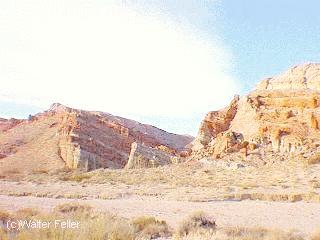
Introduction
The colorful and scenic cliffs that make up the Red Rock Canyon have
fascinated visitors and travelers for more than a century. Located
in the southern El Paso Mountains, these colorful cliffs with their stark
beauty and unique features have attracted hikers, geologists,
paleontologists, and campers.
Plants and Animals
Diverse plant and animal life is represented in the park. Joshua trees,
typical of the sandy, well drained soils of the higher desert mix
readily with the cheesebush, bursage and indian tea. Lower desert
saltbrushes that are able to tolerate high concentrations of salts
are represented here, too. Also abundant is the creosote bush which is
found throughout the Mojave Desert. Scientists think that creosote may
be one of the oldest living plants known to us since many individuals
are actually clones of much older plants.
Natural Preserves
Natural Preserves have been set aside within the park to protect
Red Rock's unique geology, vegetation, and wildlife. Here you will
find plants like the fishhook cactus, desert holly, and the rare Red Rock
tarplant.
Wildflowers
In the spring, wildflowers may be abundant if there has been sufficient rainfall and cold temperatures during
the winter. Goldfields, lupines, indian paintbrush, sand verbena and two hundred other species of flowering
plants may color the landscape in April. In the fall rabbitbrush is in full bloom with beautiful splashes of
yellow that brighten the landscape.
Wildlife
Wildlife is abundant although not always visible. Birds both residential and migratory, are numerous. Reptiles,
small mammals, and numerous insects also live here. Desert dwelling animals will hide from the noonday sun
seeking the shelter of a plant of burrow and emerge during the cooler hours of the day.
Native Americans
Indigenous people lived in the Red Rock Canyon. The
Kawaiisu,
an offshoot of the
Ute-Chemehuevi,
were a peaceful people who lived and traveled in small family units from the Tehachapis to the southern affluents
of the Kern River and the eastern slopes of the mountains including Red Rock Canyon.
Geology
The geologic story of Red Rock Canyon is told by its unique rock formations. Layers of red and white
sediments,
creating the accordion-like folds in the cliff faces, are capped with a harder, more resistant
black basaltic rock or pink volcanic tuff. These sedimentary and igneous layers were deposited in an ancient
inland lake and valley millions of years ago and have subsequently been lifted by the Garlock, El Paso, and
Sierra Frontal Faults. Streams and rivers have carved the canyon that we see today with its colorful cliff
faces. The red coloring between the layers is an iron oxide (rust) staining.
Paleontology
Miocene
fossils
have been found in the cliffs of Red Rock Canyon. Scientists continue to make discoveries
here. The Visitor Center is a good place to find a more complete story on the
geology
and
paleontology
of
Red Rock Canyon.